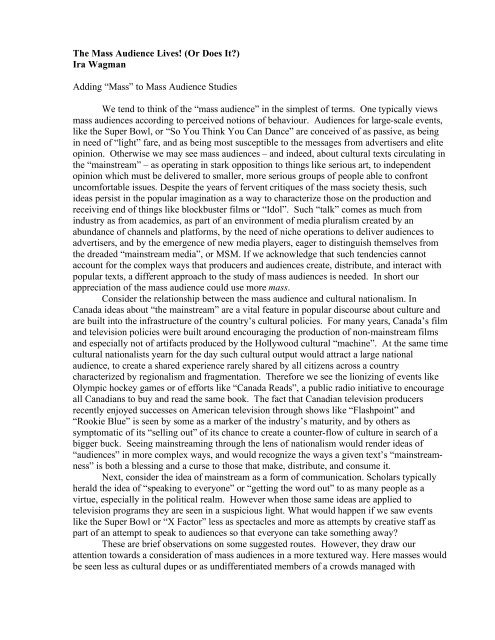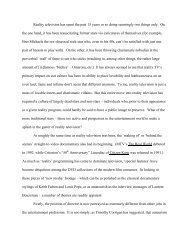The Mass Audience Lives! (Or Does It?) Ira Wagman Adding ... - Flow
The Mass Audience Lives! (Or Does It?) Ira Wagman Adding ... - Flow
The Mass Audience Lives! (Or Does It?) Ira Wagman Adding ... - Flow
You also want an ePaper? Increase the reach of your titles
YUMPU automatically turns print PDFs into web optimized ePapers that Google loves.
<strong>The</strong> <strong>Mass</strong> <strong>Audience</strong> <strong>Lives</strong>! (<strong>Or</strong> <strong>Does</strong> <strong>It</strong>?)<br />
<strong>Ira</strong> <strong>Wagman</strong><br />
<strong>Adding</strong> “<strong>Mass</strong>” to <strong>Mass</strong> <strong>Audience</strong> Studies<br />
We tend to think of the “mass audience” in the simplest of terms. One typically views<br />
mass audiences according to perceived notions of behaviour. <strong>Audience</strong>s for large-scale events,<br />
like the Super Bowl, or “So You Think You Can Dance” are conceived of as passive, as being<br />
in need of “light” fare, and as being most susceptible to the messages from advertisers and elite<br />
opinion. Otherwise we may see mass audiences – and indeed, about cultural texts circulating in<br />
the “mainstream” – as operating in stark opposition to things like serious art, to independent<br />
opinion which must be delivered to smaller, more serious groups of people able to confront<br />
uncomfortable issues. Despite the years of fervent critiques of the mass society thesis, such<br />
ideas persist in the popular imagination as a way to characterize those on the production and<br />
receiving end of things like blockbuster films or “Idol”. Such “talk” comes as much from<br />
industry as from academics, as part of an environment of media pluralism created by an<br />
abundance of channels and platforms, by the need of niche operations to deliver audiences to<br />
advertisers, and by the emergence of new media players, eager to distinguish themselves from<br />
the dreaded “mainstream media”, or MSM. If we acknowledge that such tendencies cannot<br />
account for the complex ways that producers and audiences create, distribute, and interact with<br />
popular texts, a different approach to the study of mass audiences is needed. In short our<br />
appreciation of the mass audience could use more mass.<br />
Consider the relationship between the mass audience and cultural nationalism. In<br />
Canada ideas about “the mainstream” are a vital feature in popular discourse about culture and<br />
are built into the infrastructure of the country’s cultural policies. For many years, Canada’s film<br />
and television policies were built around encouraging the production of non-mainstream films<br />
and especially not of artifacts produced by the Hollywood cultural “machine”. At the same time<br />
cultural nationalists yearn for the day such cultural output would attract a large national<br />
audience, to create a shared experience rarely shared by all citizens across a country<br />
characterized by regionalism and fragmentation. <strong>The</strong>refore we see the lionizing of events like<br />
Olympic hockey games or of efforts like “Canada Reads”, a public radio initiative to encourage<br />
all Canadians to buy and read the same book. <strong>The</strong> fact that Canadian television producers<br />
recently enjoyed successes on American television through shows like “Flashpoint” and<br />
“Rookie Blue” is seen by some as a marker of the industry’s maturity, and by others as<br />
symptomatic of its “selling out” of its chance to create a counter-flow of culture in search of a<br />
bigger buck. Seeing mainstreaming through the lens of nationalism would render ideas of<br />
“audiences” in more complex ways, and would recognize the ways a given text’s “mainstreamness”<br />
is both a blessing and a curse to those that make, distribute, and consume it.<br />
Next, consider the idea of mainstream as a form of communication. Scholars typically<br />
herald the idea of “speaking to everyone” or “getting the word out” to as many people as a<br />
virtue, especially in the political realm. However when those same ideas are applied to<br />
television programs they are seen in a suspicious light. What would happen if we saw events<br />
like the Super Bowl or “X Factor” less as spectacles and more as attempts by creative staff as<br />
part of an attempt to speak to audiences so that everyone can take something away?<br />
<strong>The</strong>se are brief observations on some suggested routes. However, they draw our<br />
attention towards a consideration of mass audiences in a more textured way. Here masses would<br />
be seen less as cultural dupes or as undifferentiated members of a crowds managed with
messages aimed at “the lowest common denominator” and more as diverse subjects who may<br />
come together on certain occasions before slipping back into a different crowd until the next<br />
time something speaks to them.






